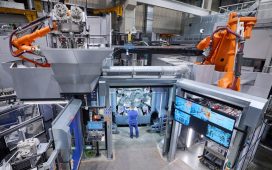On paper, EVs are kicking ass.
Electric vehicle sales are on track to hit 9 percent of all cars sold in the US by the end of the year. That’s a whopping 50 percent year-over-year increase, the second year in a row that EV sales have surged in that amount. The US is on track to buy 1 million EVs through the end of the year.
Globally, those numbers get even more impressive: 14 million projected sold for the year, a 33 percent year-over-year increase. China is “firmly in the mass-market phase of adoption,” Bloomberg notes, with plug-in cars accounting for over a third of the market. Europe is chugging along nicely as well.
So why does everything seem so out of whack? The news lately is full of production delays, factories postponed, models canceled, and, of course, the ever-present low-grade anxiety buzzing around a charging infrastructure that is both constantly broken and lacking in prevalence.
Why does everything seem so out of whack?
The news and the numbers seem wildly misaligned: Things are going great. No, wait, things are going badly. EVs are the future! Nope, EVs are a fad!
Take a breath. Unsurprisingly, there are a lot of different trend lines — price fluctuations, new incentives, the autoworkers strike, to name a few — that are colliding to make a mess of any attempt to get a solid temperature read on the EV transition. Political polarization is also making a rude cameo, which, in a presidential election, is sure to get worse before it gets even more worse. But there’s no harm in trying to sort things out.
The end of the early adopters
For dealers, selling an EV to someone wearing an Apple Watch has never been that hard. Same goes for the Patagonia vests, the Allbirds sneakers, and the like. It’s all the people with analog watches and Sketchers who are the challenge.
The early adopters have all, well, adopted. And everyone else isn’t feeling that willing to take risks in their car buying, said Jessica Caldwell, director of insights at Edmunds.
“EV adoption is looking to move into its next phase — requiring much more mass-market interest — and this larger cohort has to be sold on EVs since they aren’t as enthusiastic and willing as early adopters,” she said.
This will be much more challenging for dealers: converting a whole cohort of more trepidatious, price-sensitive shoppers to an entirely new technology. Buying an EV isn’t just about bigger screens, faux grilles, or light bars; it’s an entirely new lifestyle, full of range considerations and charging anxieties and home equipment installations.
The early adopters have all, well, adopted
Sure, there’s a range of federal and state incentives in the mix that are designed to make it an easier sell, but those incentives are often difficult to navigate. Most people haven’t even heard of them. And honestly, who even has the time for all this? I’m exhausted even thinking about it.
“The world will inevitably embrace EVs, but the adoption curve will likely be jagged with periods of stagnation,” Caldwell said, “which is what we see playing out now as automakers are now toning down some of their previously bullish plans.”
Ambition meets reality
Some of those newly toned-down plans include:
- Ford pausing $12 billion in new EV factory spending due to slower customer demand;
- GM pushing back production launches of its slate of electric trucks and SUVs, including the Chevy Silverado and Equinox EVs, as well as the GMC Sierra Denali EV;
- The company is also pushing EV truck production at its Orion facility, which was supposed to start next year, until late 2025;
- Honda and GM cancel their plans to jointly develop a slate of affordable EVs, arguing they couldn’t make the math work;
- Tesla CEO Elon Musk wringing his hands over interest rates for almost an entire earnings call, while also appearing to dial back plans to build a new factory in Mexico;
- Speaking of Tesla, the EV leader’s profit margins hit a four-year low in the third quarter of this year, as the company continues to navigate the price war it started;
- Hertz, admitting that its newly purchased EVs are twice as expensive to fix as its gas cars, is slimming down its EV plans;
- Citing subsidies and competition from China, Volkswagen said it would stop making two of its flagship EVs, the ID.3 and Cupra’s Born.
It’s gotten so bad, that now even notorious EV skeptic (and former CEO of Toyota) Akio Toyoda is going around basically being like “I told you so.” Conventional wisdom was that Toyota was in danger of going extinct due to its failure to jump on the EV bandwagon as enthusiastically as its competitors. The company was constantly being pestered by environmentalists doing their best Rod Tidwell impression to “show us the EVs!”
“The world will inevitably embrace EVs, but the adoption curve will likely be jagged with periods of stagnation.”
But Toyoda’s preference for hybrids over pure battery-electric vehicles now seems prescient, especially as more US car buyers drift toward hybrids. “People are finally seeing reality,” Toyoda told reporters at the Japan Mobility Show recently, according to The Wall Street Journal. “There are many ways to climb the mountain that is achieving carbon neutrality.”
Big trucks, big headaches
US automakers bear a lot of the blame, too. They assumed that current demand patterns could also be applied to EVs, which is why most of them prioritized big trucks and SUVs right out of the gate. GM especially was guilty of this, leading with the Hummer EV truck and SUV, while letting the small, utilitarian Chevy Bolt languish for many years before being recalled and then discontinued.
But you can’t just build plug-in trucks that need batteries as heavy as a Honda Civic if your supply chain isn’t healthy and mature. Average battery pack sizes have gone up 10 percent each year from 2018 to 2020, according to Bloomberg, from 40kWh to 60kWh. And that rate of increase is expected to accelerate as more big, heavy trucks hit the market, from the Chevy Silverado EV to the Ram 1500 Rev to the Tesla Cybertruck.
US automakers bear a lot of the blame
Automakers say they are responding to customer demands for longer ranges and more dependable battery sizes. But the supply chain is going to find it very difficult to keep up with the pace, especially as US policymakers try to redirect the production of battery materials away from China.
Of course, this is what is making EVs more expensive — too expensive for most people, taking into account the recent drop in demand. China, meanwhile, is eating our lunch by prioritizing small, inexpensive models that are affordable to middle-class shoppers. The average price of an EV in China was less than 32,000 euros, or $35,000, in the first half of 2022, according to researchers at Jato Dynamics. In the US, it’s around $53,000.
That number is dropping, mostly because of Tesla’s relentless price-cutting. But those decreases could start to plateau as more EVs enter the market — especially all the aforementioned big, expensive trucks — and Tesla’s market share (now at around 50 percent) continues to drop.
“A political football”
Quite possibly the worst thing that can happen to any company these days is to get sucked into the vortex of American politics in the year 2023. When Republican politicians start calling you “woke,” it’s about to get very, very dumb very, very quickly.
Some might argue we’re already there. Former President Donald Trump lambasted EV batteries as “very bad for the environment” but also decried “environmental lunatics” who were pushing for EVs. Florida Governor Ron DeSantis said he would repeal “Biden’s EV mandates.” Nikki Haley too, because “half of the batteries for electric vehicles are made in China.” Vivek Ramaswamy held a political rally in opposition to a new battery plant in Michigan and said people who bought EVs were displaying “a psychological insecurity.”
For better or worse, EVs are now political, and automakers are left to grapple with the challenges that arise when a significant chunk of the population refuses to buy your product based on ideology.
For better or worse, EVs are now political
From 2012–2022, more than half of new EV registrations were in the top 10 percent most Democratic counties, according to a working paper from UC Berkeley. About one-third went to the top 5 percent of Democratic counties. In short, EV adoption is a big thing in blue states, not so much in red states.
“Enough time has passed – one might have thought – for the U.S. EV market to have broadened considerably,” the authors conclude. “Yet we find a strong and enduring correlation between political ideology and U.S. EV adoption.”
Even Elon Musk’s status as chief opponent to the so-called “woke mind virus” may not be enough to sway right-leaning consumers. The prevailing evidence is the fact that President Joe Biden has hitched his political wagon to EVs. Electrification is a major pillar of the White House’s efforts to fight climate change. The administration is channeling billions of dollars toward tax credits for consumers, charging infrastructure, and manufacturing incentives.
And now Republicans have to oppose all these things despite whether doing so is, in relative terms, “good politics.” Biden’s doing it, so it’s bad. And Tesla, the most popular brand on the market, has also become uniquely polarized, thanks to Musk’s trollish online antics.
“They have become a political football,” Ford CEO Jim Farley said recently.
Sticker shock
But it isn’t purely politics. EVs have a real pricing problem. They are too expensive.
Polling firm Strategic Vision, which surveys new car buyers, found that the median family household income of new car buyers has risen from $90,000, where it was for several decades, to $122,000 in recent years. And people who buy EVs are even more well-off, with a median household income of $186,000.
EVs won’t truly take off if they are viewed as only being for rich liberals. And unfortunately, right now, with interest rates at a 22-year high, people just don’t have enough money to spend on a new car.
“After a decade of bigger, grander spending during a period of low interest rates, consumers are having to size down on their purchases,” Caldwell said, “not because they necessarily want to but because it’s what they can afford.”
Update November 2nd 1:50PM ET: One million EVs will be sold in the US this year. A previous version of this story characterized that figure incorrectly.












